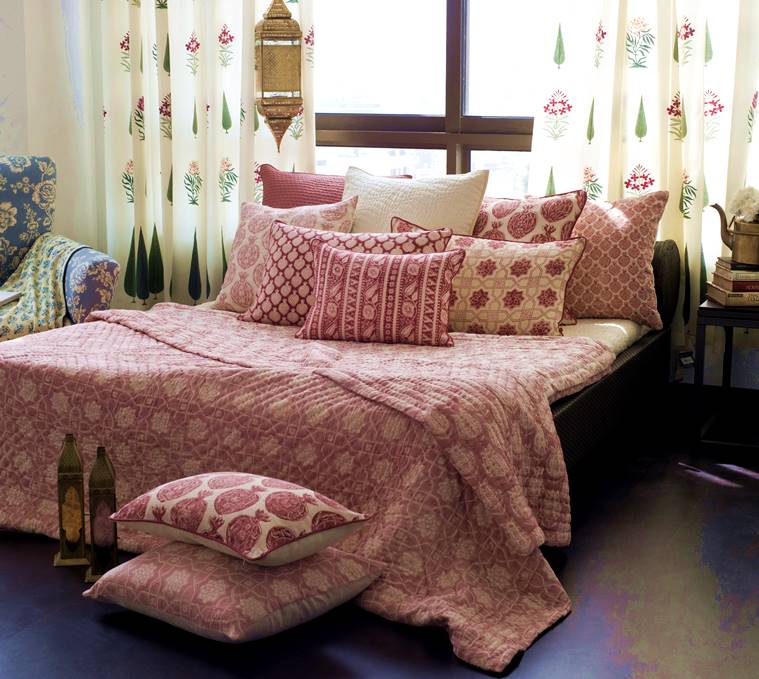 High Street: Ritu Kumar’s chintz collection modelled by Miss India contestants Manushi Chillar (left) and Priyanka Kumari.
High Street: Ritu Kumar’s chintz collection modelled by Miss India contestants Manushi Chillar (left) and Priyanka Kumari.
It was on a rainswept morning in London that designer Ritu Kumar first got acquainted with chintz at an exhibition at the Victoria & Albert (V&A) Museum. She noticed the repetition of printed chintzes on vintage wall-hangings and gowns from a bygone era. “I was mesmerised with the concepts and the genius of both design and colouring, but had no idea that this was something that emanated from India. Seeing the large-sized hangings, which must have once been used as the interior of tents for armies on the move, creating virtual interiors of palaces, was stunning in its conception and execution. I couldn’t wait to know more,” says the textile revivalist, who, upon her return to India, embarked on a love affair that has made the flower-festooned craft a cornerstone of her 50-year-old label.
Much like Kumar, couturier Sabyasachi Mukherjee’s floral fixation with what is arguably India’s first fashion export to the world — the ancient art of block-printed chintz — makes its presence felt in all that he does, spanning mediums and disciplines. From floral organza saris and 200-count Khadi chintz curtains in his flagship stores, to chintz-upholstered custom-made rickshaws for charity events, and designer wallpaper for Nilaya (by Asian Paints) — cheent (drops of water) as it is known locally, is a big part of his creative oeuvre. Magnified flowers in hyper-volatile hues rendered by the artisans of The Sabyasachi Art Foundation bloom on Khadi ijar pants, off-white saris and bleached cotton quilted jackets as part of his spring/summer 2018 collection An Endless Summer as well. “The heartland of India wears cheent,” says the designer in an Instagram post on his perennial “obsession”.
And to think that it was from Machilipatnam, in the heartland of the Coromandel Coast, now Andhra Pradesh, that this ancient technique of printing fabric travelled to the world and became an indelible part of India’s rich textile history. The traditional process, known as mordant and resist-dyeing, involved hand-drawing with a bamboo pen (kalam) giving it its local term kalamkari. Chintz soon became a generic term for the hand-painted cotton fabrics that were imported in large quantities into Britain and The Netherlands in the 17th-18th centuries.
But there is nothing remotely generic about this craft that is currently enjoying a resurgence in mainstream fashion. “I do not know of any other school with such a wide variety or scope in stylising flower and plant motifs as which comes from the school of kalamkari,” says Kumar. The V&A archives corroborate how the hybrid floral designs characteristic of chintz fabrics of the early 18th century are the product of a complex interaction of trade between India, Europe and East Asia, leading to a combination of elements from English embroidery, Islamic floral designs and Chinese ceramics, among other things.
This versatility finds resonance in the works of designers like Anamika Khanna, Payal Singhal, Nikasha Tawadey Khemka, Aneeth Arora of Péro and Payal Pratap, as well as design houses like Good Earth, Nicobar, Fabindia, Jaypore and Anokhi, who have explored chintz through various creative collaborations and experimental iterations. Singapore-based Nikasha recalls how her debut fashion week collection in 2006 featured chintz prints. “Calcutta was such a beautiful fusion of Bengali and British sensibilities. My collection, inspired by The Great Eastern Hotel, that stood a few buildings away from our house in Chowringhee (Kolkata), embodied that. Mom would buy chintz table and cushion covers from a shop called The Good Companions. Chintz prints make an appearance in most of my collections and I always try to find ways to contemporise it,” says Nikasha. Her autumn/winter 2018 line Keya juxtaposes her favourite chintz with foil-printing.
 At Good Earth, chintz patterns are created by kalamkari craftsmen from Machilipatnam on clothes as well as home textiles.
At Good Earth, chintz patterns are created by kalamkari craftsmen from Machilipatnam on clothes as well as home textiles.
At Good Earth and sister brand Nicobar, the craft finds new interpretations every season. “We collaborate with highly-skilled craftsmen in Machilipatnam and have developed a colour palette that we hope will popularise this craft, so that its artisans may flourish and sustain their tradition once more,” says Simran Lal, chief executive officer, citing their sponsorship of the 2016 “Fabric of India” exhibit at the V&A, where kalamkari craft was a central feature.
It was an archival chintz piece from this very exhibition that became a central print in Abraham & Thakore’s 2018 trans-seasonal collection #sadaksmart. While the cacophony of riotous chintz seen on Indian streets was the starting point, David Abraham thinks the printing tradition’s syncretic legacy is far more laudable, particularly in view of the ongoing nationalist argument. “It is a textile tradition that highlights the beauty of India’s craftspeople and their willingness to work with everybody in order to produce something beautiful and expand their market. The European traders brought their pattern books with flowers and chinoiserie and the craftspeople incorporated these and made them their own. That symbolised the success of syncretism in Indian textiles,” says Abraham.
THE BACKSTORY
The textile — hand-printed/ painted floral-patterned muslin cloth— originated in the Indian subcontinent in the 1600s. A complex dyeing process, using natural dyes like madder and indigo, gave it its vibrant colours. The name stems from the Sanskrit word citra (variegated), and the Hindi cheent. Chintz, the style incorporates the patterns of intricate flower, fruit and bird illustrations, influenced by Persian motifs, which owes its origin to the patronage of the Muslim rulers in Golconda. An instant hit with British women, the patterns, over time, became more European-looking, the floral motifs, smaller and colours, pastel.
– Simran Lal, CEO, Good Earth and creative director, Nicobar.